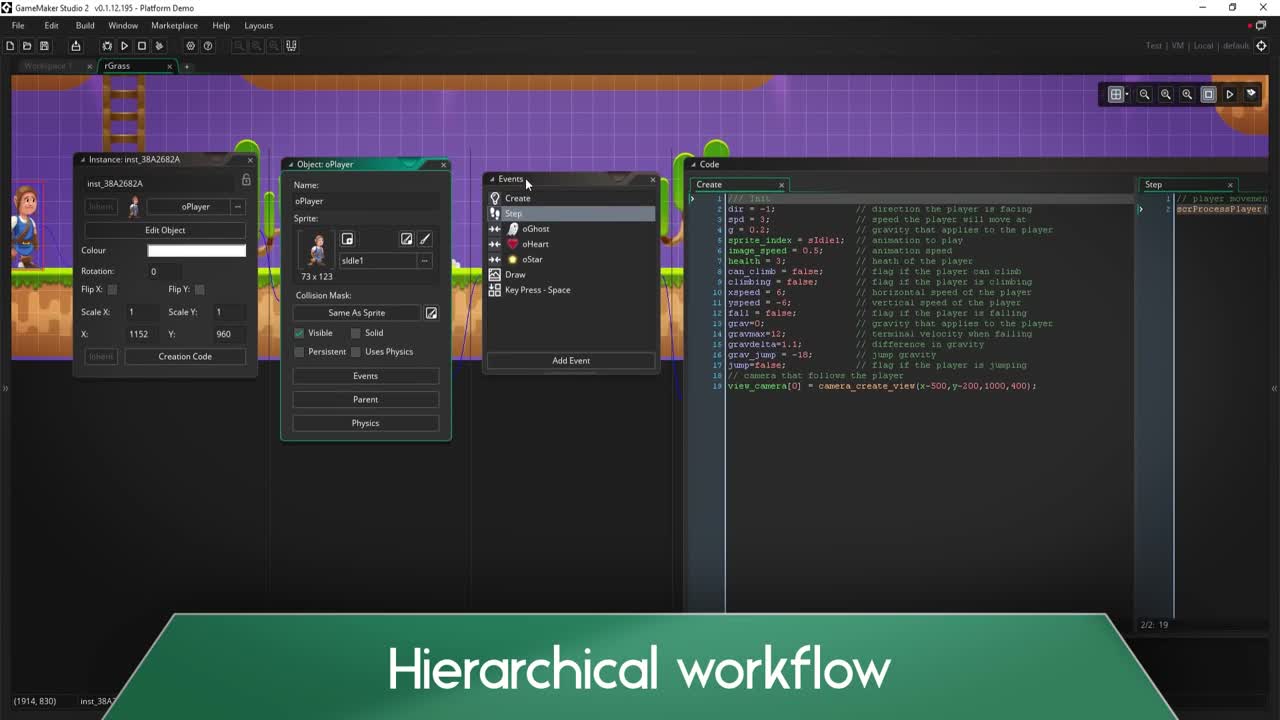

- Gamemaker studio 2 room speed update#
- Gamemaker studio 2 room speed software#
- Gamemaker studio 2 room speed code#
These uncontrolled factors can defeat all your efficient programming and give a poor experience at runtime on a system with insufficient resources to perform all the instructions that it needs to, on time. You can’t control what other processes might also be running on that system, in the background, while the game program is running. You can’t control what hardware the user will run the game on. Those are both significant downsides, but even so you can create a great many games within those constraints these days, without too much of a problem.īut there’s still things that are out of your control, even if you write a small program with very efficient code.

Doing this requires that you mostly write small, simple games, and run them on hardware robust enough that it will easily be able to guarantee that sufficient resources are available in order to complete the computation required, on time, every step.
Gamemaker studio 2 room speed code#
The solution is to write efficient code that has an extremely good chance of running all the calculations for the next game state before that game state is needed for drawing the game to the display, so that there will never be a delay that results in a dropped frame.
Gamemaker studio 2 room speed software#
The second is well beyond your control, unless you’re writing software that has direct control over the hardware it’s running on, rather than writing an application that runs on top of an operating system that also supports numerous other multi-tasking programs and services. The first is very unlikely, and would impose constraints that would make the program’s design very rigid. It’s not really avoidable to avoid the problem completely, you would need to write the game in such a way that it was guaranteed that the program always requires the same amount of calculations to be performed per step, and always has the same system resources available to perform those calculations. The program will not crash, but it may slow down or stutter, or perform in a jerky manner. But if those resources are not available, or if the game demands too much work be done to allow the available system resources to create the next game state in time, the game will not run smoothly. As long as the computer has plenty of resources, it should have plenty of time to generate the next game state.
Gamemaker studio 2 room speed update#
We can run into problems, though, because of the limitations of the computer hardware to perform all the calculations needed during the update loop to generate the next game state. As long as the program is able to do so, everything will run as desired. Just set the desired frame rate and let GameMaker manage itself to try to achieve this target frame rate. This simple approach, simply setting a frame rate through the Game FPS or room_speed properties, works well enough for many projects. (Cog symbol) -> Main options -> General and set “Game frames per second”.

In GMS2, room_speed is replaced by a global option in the project’s properties. Typically, this is set to a value that aligns nicely to the refresh rate of the display - often 30 or 60. In older versions of GameMaker, there’s a room property, room_speed, which sets a target number of steps the update loop will attempt to execute per second. This required great effort and intimate understanding of the hardware and program code.įor the most part, GameMaker makes things simple enough for basic game development, and you don’t have to worry about regulating the frame rate yourself. Back in the old days, when games were programmed in Assembly for specific hardware platforms, and the game program ran on the bare metal, the programmer relied on the CPU clock and the timing it took to perform various operations to ensure that everything worked in sync. Ideally, this frame rate would be constant and unvarying.Īchieving this in practice can be quite complicated. Normally, it is desirable that the program control its frame rate, the number of times this update loop executes per second, so that a consistent frame rate is achieved, in order to have the game run smoothly and consistently. In videogames, the game program incorporates a routine called an update loop, which repeatedly applies the rules of the game to the game’s present state in order to create the next game state. If you didn’t have an introduction to this concept in your education, it can seem mysterious why we talk about “delta” like this, but it is a common convention. For example, in physics calculations, the term ΔV (pronounced “delta-vee”) is used to quantify a change in velocity as measured at two different moments in time. Why arguing about Link’s gender is dumb, and why it’s importantĭelta is a term often used in math and science to indicate change.“Null Room” hidden in Superman (Atari, 1979).video games, programming, the internet, and stuff


 0 kommentar(er)
0 kommentar(er)
